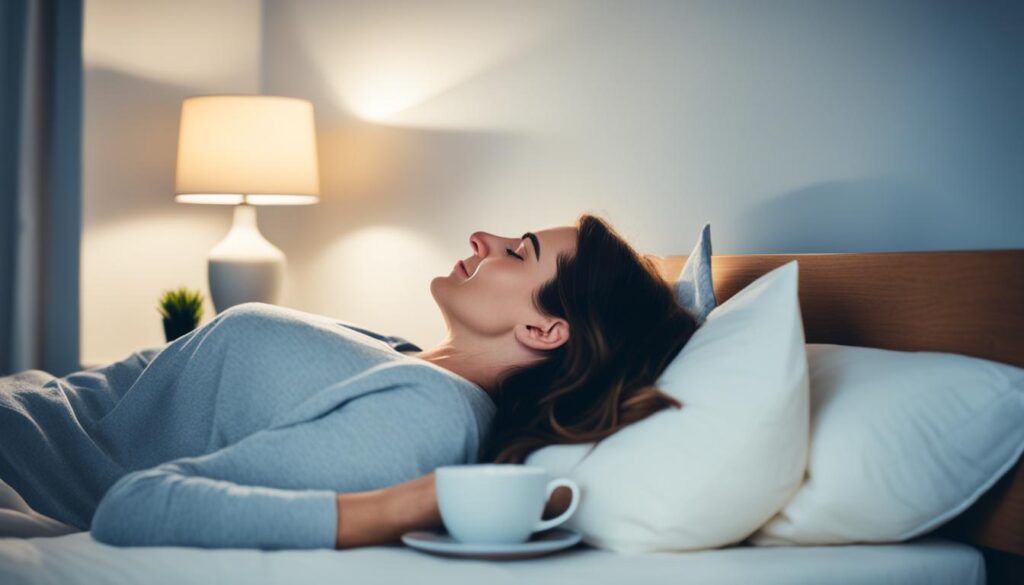Are you struggling to get a good night’s sleep? Do you find yourself tossing and turning, unable to find that elusive state of relaxation? The key to improving your sleep quality may lie in understanding and training your sleep patterns.
Sleep patterns, or sleep hygiene, refer to the behaviors and habits that can either positively or negatively impact your sleep. By implementing healthy sleep habits and optimizing your sleep environment, you can regulate your circadian rhythm and establish a bedtime routine that promotes restful sleep.
In this article, we will explore the importance of sleep hygiene, how to practice good sleep habits, and the benefits of establishing a consistent bedtime routine. We will also delve into sleep training strategies and ways to optimize your sleep environment for maximum relaxation. So, get ready to unlock the secrets to a healthier and more restorative sleep.
Key Takeaways:
- Understanding and training your sleep patterns can improve sleep quality.
- Practicing good sleep hygiene is essential for regulating circadian rhythm.
- Establishing a consistent bedtime routine can promote restful sleep.
- Optimizing your sleep environment plays a crucial role in achieving better rest.
- Implementing sleep training strategies can help establish healthy sleep patterns.
Why Is Sleep pattern Hygiene Important?
Poor sleep hygiene can have a significant impact on both the quantity and quality of your sleep. When your sleep hygiene practices are suboptimal, it can lead to various issues such as difficulty falling asleep, frequent sleep disturbances, daytime sleepiness, and inconsistent sleep patterns. These problems can affect your overall well-being, productivity, and even your mental health.
However, by prioritizing good sleep hygiene, you can promote consistent and uninterrupted sleep, resulting in numerous benefits for your overall health and well-being.
- Improved Sleep Quantity: Practicing good sleep hygiene can help you get the recommended amount of sleep that your body needs. Adults generally require 7-9 hours of sleep each night to function at their best. By following healthy sleep habits, you can ensure that you are getting enough sleep to support your body’s needs.
- Enhanced Sleep Quality: Good sleep hygiene positively influences the quality of your sleep. It helps you achieve a more restful and rejuvenating slumber, allowing your body and mind to fully recover and recharge.
- Physical Health Benefits: When you prioritize sleep hygiene, you give your body the opportunity to repair and heal itself. Quality sleep is crucial for maintaining a healthy immune system, managing weight, reducing the risk of chronic conditions, and promoting overall physical well-being.
- Mental Health Benefits: Adequate sleep is closely linked to mental health. By practicing good sleep hygiene, you can enhance your mood, cognitive function, and emotional well-being. It can help reduce the risk of developing mental health disorders such as depression and anxiety.
Establishing and maintaining good sleep hygiene habits is essential for optimizing your sleep quantity and quality. By adopting a consistent sleep routine, creating a sleep-conducive environment, and cultivating healthy sleep habits, you can experience the multitude of benefits that come with practicing good sleep hygiene.
Remember, prioritizing your sleep hygiene is an investment in your overall health and well-being. Take the necessary steps to improve your sleep hygiene and enjoy the rewards of a good night’s sleep.
Impact of Poor Sleep Hygiene vs. Benefits of Good Sleep Hygiene
| Impact of Poor Sleep Hygiene | Benefits of Good Sleep Hygiene |
|---|---|
| Difficulty falling asleep | Improved sleep quantity |
| Frequent sleep disturbances | Enhanced sleep quality |
| Daytime sleepiness | Physical health benefits |
| Inconsistent sleep patterns | Mental health benefits |
How Do You Practice Good Sleep Hygiene?
Practicing good sleep hygiene involves several key strategies. First, it’s important to establish a consistent sleep schedule by going to bed and waking up at the same time every day. This helps regulate your body’s internal clock and promotes better sleep.
Additionally, following a bedtime routine that includes calming activities like reading or relaxation exercises can signal to your body that it’s time to wind down. Creating a predictable routine before bed can help prepare your mind and body for sleep.
Other healthy sleep habits, such as avoiding caffeine and heavy meals before bed, also contribute to good sleep hygiene. Caffeine is a stimulant that can interfere with sleep, so it’s best to avoid consuming it several hours before bedtime. Similarly, heavy meals can disrupt digestion and cause discomfort, making it harder to fall asleep peacefully.
Optimizing your sleep environment is another important aspect of good sleep hygiene. Make sure your bedroom is dark, quiet, and at a comfortable temperature. Use blackout curtains or an eye mask to block out any excess light, and earplugs or a white noise machine to minimize noise disturbances. Consider investing in a supportive mattress and comfortable pillows to create a conducive sleep environment.
By prioritizing a consistent sleep schedule, following a bedtime routine, practicing healthy sleep habits, and optimizing your sleep environment, you can greatly improve your sleep hygiene and promote quality sleep.
| Sleep Hygiene Strategies | Benefits |
|---|---|
| Setting a consistent sleep schedule | Regulates body’s internal clock |
| Following a bedtime routine | Signals body to wind down and prepare for sleep |
| Avoiding caffeine and heavy meals before bed | Reduces sleep disruptions and discomfort |
| Creating a comfortable sleep environment | Promotes relaxation and better sleep quality |
Is Sleep Hygiene the Same For Everyone?
Sleep hygiene practices can vary from person to person. Each individual can tailor their sleep hygiene practices to suit their own needs and preferences. Factors such as age, lifestyle, and personal preferences can influence sleep hygiene habits. For example, the amount of sleep needed varies depending on age, with adults typically requiring 7-9 hours of sleep per night. It’s important to find a sleep routine and environment that work best for you and promote quality sleep.
When it comes to sleep hygiene, one size does not fit all. What works for one person may not work for another. It’s essential to understand your own sleep needs and adapt your sleep hygiene practices accordingly. By identifying your specific requirements and tailoring your sleep routine, you can optimize your sleep and reap the benefits of a restful night’s rest.
Age plays a significant role in determining sleep needs. Infants and young children require more sleep compared to adults, while older adults may find their sleep patterns shift due to changes in sleep architecture. Additionally, lifestyle factors such as work schedules, physical activity levels, and stress levels can impact sleep hygiene practices. Some individuals may require more structure and consistency in their sleep routines, while others may be more flexible.
Personal preferences also play a crucial role in sleep hygiene. Some people may prefer a completely dark and quiet sleep environment, while others may find a low-level noise machine or nightlight helps them sleep better. It’s important to experiment with different strategies and determine what works best for you.
To help illustrate the variations in sleep hygiene practices, below is a table highlighting some examples of individual sleep hygiene practices:
| Individual | Sleep Hygiene Practices |
|---|---|
| Marie |
|
| David |
|
| Emily |
|
As you can see, individual sleep hygiene practices can vary based on personal preferences and needs. Tailoring your sleep hygiene routine to fit your unique requirements can help you achieve optimal sleep and wake up feeling refreshed and rejuvenated.
Establishing a Bedtime Routine and Sleep Training Strategies
Establishing a consistent bedtime routine is an effective way to signal to your body that it’s time to sleep. By incorporating calming activities into your routine, such as taking a warm bath, reading a book, or practicing relaxation techniques, you can create a soothing environment that promotes relaxation and prepares your mind and body for restful sleep.
Sleep training strategies can also be beneficial for improving your sleep quality. These strategies involve adopting techniques that help regulate your sleep-wake cycle and establish healthy sleep patterns. Here are some effective sleep training techniques for both adults and children:
- Limit daytime naps: Keeping daytime naps short and avoiding late afternoon naps can help regulate your sleep schedule and ensure that you’re tired and ready for bed at night.
- Avoid stimulating activities before bed: Engaging in stimulating activities close to bedtime, such as watching TV or using electronic devices, can interfere with your ability to fall asleep. It’s best to avoid these activities at least an hour before bed.
- Use stimulus control methods: Associating your bed with sleep and relaxation is crucial for improving sleep quality. Using stimulus control methods, such as only using your bed for sleeping and not engaging in other activities like working or watching TV, can help reinforce this association.
Sleep training techniques tailored to your specific needs and preferences can help establish healthy sleep patterns and optimize your sleep quality.
Bedtime Routine Example:
| Activities | Duration |
|---|---|
| Taking a warm bath | 15 minutes |
| Reading a book | 20 minutes |
| Practicing relaxation techniques | 10 minutes |
Note: The duration of each activity in the bedtime routine example can be adjusted based on personal preferences and individual needs.
Optimizing Your Sleep Environment
Creating a comfortable sleep environment is an essential part of maintaining good sleep hygiene. By optimizing your bedroom for sleep, you can create the perfect conditions for a restful night’s sleep. Here are some valuable tips to help you create a comfortable sleep environment:
1. Invest in a Comfortable Mattress and Pillow
Avoid waking up with aches and pains by investing in a high-quality mattress and pillow. A supportive mattress that suits your preferred sleeping position can alleviate discomfort and promote better sleep. Similarly, choosing the right pillow that aligns your head and neck with your spine can prevent stiffness and reduce the risk of waking up with aches.
2. Use High-Quality Bedding
Enjoy the luxury of soft and breathable bedding materials. Opt for high-thread-count sheets and pillowcases made from natural fibers like cotton or bamboo. These materials regulate temperature, wick away moisture, and provide a cozy feel for a more comfortable sleep experience.
3. Control Temperature, Light, and Noise
Creating a sleep-conducive environment involves controlling external factors like temperature, light, and noise. Keep your bedroom cool and well-ventilated, between 60-67 degrees Fahrenheit (15-19 degrees Celsius), to promote optimal sleep. Use blackout curtains or blinds to block out excess light, and consider using earplugs or a white noise machine to minimize disruptive sounds.
4. Minimize Electronic Distractions
Electronic devices emit blue light that can interfere with your internal clock and disrupt your sleep schedule. Avoid using electronic devices, such as smartphones, tablets, or laptops, for at least an hour before bedtime. Instead, engage in relaxing activities like reading a book or practicing meditation to prepare your mind and body for sleep.
5. Create a Clutter-Free Space
A neat and organized bedroom can promote a sense of calm and relaxation. Declutter your sleeping area by removing unnecessary items and keeping surfaces clear. A tidy space can help reduce distractions and create a peaceful environment conducive to sleep.
By implementing these tips and optimizing your sleep environment, you can enhance your sleep quality and wake up feeling refreshed and rejuvenated. Remember, a comfortable sleep environment is a key component of good sleep hygiene.
Conclusion
Improving sleep quality and optimizing sleep patterns through healthy sleep habits is crucial for overall well-being. By practicing good sleep hygiene, establishing a consistent bedtime routine, and creating a sleep-conducive environment, you can enhance the quality and quantity of your sleep.
Quality sleep plays a vital role in promoting physical and mental health. It improves cognitive function, enhances mood, boosts immune function, and supports overall brain health. By prioritizing sleep, you can unlock numerous benefits for your body and mind.
Remember, mastering your sleep patterns is a personal journey that requires dedication and commitment. Experiment with different strategies, such as setting a regular sleep schedule, engaging in relaxing activities before bed, and optimizing your sleep environment. Find what works best for you and consistently prioritize healthy sleep habits.
Frequently Asked Questions
What is sleep hygiene?
Sleep hygiene refers to both your sleep environment and behavior. It includes setting a strict sleep schedule, following a bedtime routine, forming healthy habits, and optimizing your bedroom for sleep.
Why is sleep hygiene important?
Sleep hygiene is important because it can improve both the quantity and quality of your sleep. Poor sleep hygiene can lead to difficulties falling asleep, frequent sleep disturbances, daytime sleepiness, and inconsistent sleep patterns. On the other hand, practicing good sleep hygiene can promote consistent, uninterrupted sleep and improve physical and mental health.
How can I practice good sleep hygiene?
You can practice good sleep hygiene by establishing a consistent sleep schedule, following a bedtime routine that includes calming activities, avoiding caffeine and heavy meals before bed, and creating a comfortable sleep environment.
Is sleep hygiene the same for everyone?
No, sleep hygiene practices can vary from person to person. Each individual can tailor their sleep hygiene practices to suit their own needs and preferences, taking into account factors such as age, lifestyle, and personal preferences.
How can I establish a bedtime routine and use sleep training strategies?
You can establish a bedtime routine by engaging in activities like taking a warm bath, reading a book, or practicing relaxation techniques. Sleep training strategies may involve techniques like limiting daytime naps, avoiding stimulating activities before bed, and using stimulus control methods to associate the bed with sleep and relaxation.
How can I optimize my sleep environment?
You can optimize your sleep environment by ensuring you have a comfortable mattress and pillow, using high-quality bedding, and controlling factors like temperature, light, and noise in your bedroom. Creating a cool, dark, and quiet sleep environment can promote better sleep.
How can I improve my sleep quality and develop healthy sleep habits?
You can improve your sleep quality and develop healthy sleep habits by practicing good sleep hygiene, establishing a consistent bedtime routine, and optimizing your sleep environment. By paying attention to your sleep patterns and training, you can achieve better rest and overall well-being.


















